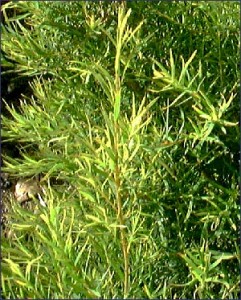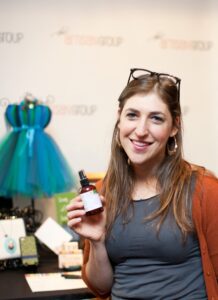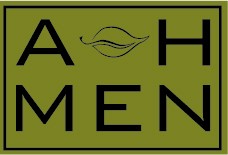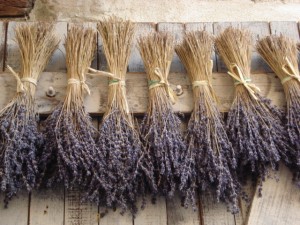

This is the first post in a series, to introduce the most commonly used essential oils. Common facts about tea tree oil (melaleuca alternafolia):
– the melaleuca plant is part of the Myrtaceae family
– the most common plant is a small shrub or tree
– this plant is indigenous to Australia, but is now grown in many other countries
– the leaves are steam distilled, to obtain the essential oil
– it’s scent is medicinal and herbal
Tea tree oil is best known for it’s antibacterial 2,3&4, antifungal9 and antiviral5&6 properties. It has shown to be effective against Staphylococcus strains, including MRSA, and Streptococcus strains.10 If using the oil neat (undiluted) it may irritate sensitive skin, so it’s recommended that a patch test be done prior to use.
There are a number of ailments, of which the use of tea tree oil can aid in recovery:
Acne (acne vulgaris): apply a drop of oil directly to the affected area, add to a natural facial cleanser, or add to distilled water to make a facial toner.11&13
Athletes Foot (tinea pedis): after cleaning your feet well, apply the oil neat to the affected area, add a few drops to a foot bath or add a few drops to a lotion or baking soda base, and apply to the feet.14&15
Chicken pox: as tea tree oil relieves itching, it can be applied to the rash and blisters.
Colds and ‘Flu: the oil can be applied on the back, chest and feet in a lotion base, along with other expectorant and antiviral oils such as eucalyptus and thyme.4&5
Cold sores (herpes labialis): apply a couple drops of oil directly to the sore with a cotton swab.6
Cuts and scrapes: the oil can be applied neat to the area then covered with a bandage.
Gum inflammation: 3-5 drops of oil can be added to a cup of water. To improve the taste of the tea tree, peppermint essential oil can also be added. Be sure not to swallow the mixture. As well, to clean your toothbrush, add one drop of tea tree oil.1&2
Insect Bites: add tea tree oil directly to the bite, to disinfect the area and help with the itching. (including flea, mosquito, horse fly bites).
Lice: the oil can be added to a gentle, unscented shampoo and conditioner.8 A few drops can also be added to the laundry when bedding is washed. Be sure you’re combing through your or your child’s hair with a finely toothed metal comb.
Sinuses: as above for colds.4
Warts: apply a drop of oil, neat, directly to the wart.3
Yeast infections (candidiasis or thrush): add 7-10 drops of oil to a bath, up to your pelvic bone, and soak for 10-15 minutes. A few drops can also be added to a panty liner.9&10
Additional types of infections include eczema7, herpes simplex6, nail infections, ringworm, earaches, allergies12 and scabies, for which tea tree oil can be beneficial.
It is also great for cleaning, if you would like to avoid the chemicals found in many commercial cleaning products. It can be used for mold, in a general cleaning spray, added to the dishwater, added to the laundry and used in an antiseptic spray.
Michelle Reynolds, CAHP
1. Effect of mouthwashing with tea tree oil on plaque and inflammation. Saxer UP, Stauble A, Szabo SH, Menghini G. Schweiz Monatsschr Zahnmed. 2003;113(9):985-96. PMID: 14567294
2. Susceptibility of oral bacteria to Melaleuca alternifolia (tea tree) oil in vitro. Hammer KA, Dry L, Johnson M, Michalak EM, Carson CF, Riley TV. Oral Microbiol Immunol. 2003 Dec;18(6):389-92. PMID: 14622345
3. Successful topical treatment of hand warts in a paediatric patient with tea tree oil (Melaleuca alternifolia). Millar BC, Moore JE. Complement Ther Clin Pract. 2008 Nov: 14(4):225-7. PMID: 18940708
4. Antibacterial activity of essential oils and their major constituents against respiratory tract pathogens by gaseous contact. Shigeharu Inouye, Toshio Takizawa and Hideyo Yamaguchi. Journal of Antimicrobial Chemotherapy (2001) 47, 565-573.
5. In vitro antiviral activity of Melaleuca alternifolia essential oil. Gazozzo A, Timpanaro R, Bisignano B, Ferneri PM, Bisignano G, Castro A. Department of Microbiological and Gynaecological Sciences, University of Catania, Catania, Italy. PMID: 19843207
6. Comparative study on the antiviral activity of selected monoterpenes derived from essential oils. Astani A, Reichling J, Schnitzler P. Phytother Res. 2009 Aug 3. PMID: 19653195
7. Tea tree oil attenuates experimental contact dermatitis. Wallengren J. Arch Dermatol Res. 2010 Sep 24. PMID: 20865268
8. A randomised, assessor blind, parallel group comparative efficacy trial of three products for the treatment of head lice in children–melaleuca oil and lavender oil, pyrethrins and piperonyl butoxide, and a “suffocation” product. Barker SC, Altman PM. BMC Dermatol. 2010 Aug 20;10:6. PMID: 20727129
9. Inhibition of Candida albicans biofilm formation by antimycotics released from modified polydimethyl siloxane. De Prijck K, De Smet N, Honraet K, Christiaen S, Coenye T, Schacht E, Nelis HJ. Mycopathologia. 2010 Mar;169(3):167-74. PMID: 19774486
10. The battle against multi-resistant strains: Renaissance of antimicrobial essential oils as a promising force to fight hospital-acquired infections. Warnke PH, Becker ST, Podschun R, Sivananthan S, Springer IN, Russo PA, Wiltfang J, Fickenscher H, Sherry E. J Craniomaxillofac Surg. 2009 Oct;37(7):392-7. PMID: 19473851
11. The efficacy of 5% topical tea tree oil gel in mild to moderate acne vulgaris: a randomized, double-blind placebo-controlled study. Enshaieh S, Jooya A, Siadat AH, Iraji F. Indian J Dermatol Venereol Leprol. 2007 Jan-Feb;73(1):22-5. PMID: 17314442
12. Tea tree oil reduces histamine-induced skin inflammation. Koh KJ, Pearce AL, Marshman G, Finlay-Jones JJ, Hart PH. Br J Dermatol. 2002 Dec;147(6):1212-7. PMID: 12452873
13. A comparative study of tea-tree oil versus benzoylperoxide in the treatment of acne. Bassett IB, Pannowitz DL, Barnetson RS. Med J Aust. 1990 Oct 15;153(8):455-8. PMID: 2145499
14. A novel aromatic oil compound inhibits microbial overgrowth on feet: a case study. Misner BD. J Int Soc Sports Nutr. 2007 Jul 13;4:3. PMID: 17908343
15. Treatment of interdigital tinea pedis with 25% and 50% tea tree oil solution: a randomized, placebo-controlled, blinded study. Satchell AC, Saurajen A, Bell C, Barnetson RS. Australas J Dermatol. 2002 Aug;43(3):175-8. PMID: 12121393











